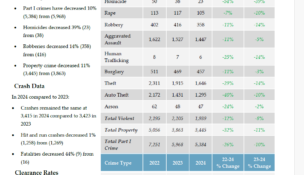Conviction upheld despite erroneous instruction
By: dmc-admin//September 21, 2005//
The Seventh Circuit upheld a conviction for felon in possession of a firearm, even though the jury instructions permitted them to find the defendant guilty for conduct “on or about” a particular date, when, because of statute of limitation issues, they actually needed to find him guilty of the conduct on a particular date.
In its Sept. 12 decision, the court also upheld enhancement of the sentence for possessing the firearm in connection with heroin trafficking, even though no heroin was recovered in the search that resulted in recovery of the firearms.
In 1998, Illinois police became suspicious of Martin Caldwell, after his mother was kidnapped and he raised $100,000 in ransom money in less than an hour, despite apparently having very limited means.
After some surveillance, the police arrested an associate of Caldwell’s, Mario Young, on Sept. 17, 1998, and found 76 grams of heroin in his possession. Young stated he bought the drugs from Caldwell, had paid Caldwell $10,000 the day before as partial payment, and that Caldwell had been supplying him with heroin for approximately six months.
On Sept. 18, 1998, a search warrant was executed at Caldwell’s home. Three guns were found, as was $57,000 in cash. However, except for some marijuana, no controlled substances were discovered.
Caldwell was not charged until Sept. 17, 2003 (the day before expiration of the statute of limitations), with two counts of being a felon in possession of a firearm.
At trial, Caldwell did not dispute that he was a felon, or that the firearms had traveled in interstate commerce; the only issue was possession.
|
What the court held Case: U.S. v. Martin Caldwell, No. 04-1929. Issue: Is there sufficient evidence to convict a defendant of felon in possession of a firearm, even though the standard date of offense instruction was improperly given? Was the defendant’s sentence properly enhanced for possessing firearms "in connection with drug trafficking," even though no heroin was recovered with the firearms? Holding: Yes. Although it is possible the jury decided the case in an impermissible fashion, the verdict must be affirmed because a rational juror could have found the essential elements of the crime to be met. Yes. Where $57,000 was found in a secret compartment of a vehicle, along with one of the firearms, and a witness testified that the compartment was used for drug trafficking, the enhancement was properly used. |
The indictment charged that Caldwell possessed the firearms “on or about Sept. 18, 1998,” and the jury was instructed in accordance with the indictment. They found him guilty.
At sentencing, the district court enhanced his sentence for a number of reasons, one of them being that he possessed the firearm in connection with another felony offense — drug trafficking. The court sentenced Caldwell to 57 months, the highest sentence within his guideline range.
Caldwell appealed, but the Seventh Circuit affirmed in a decision by Judge William J. Bauer, but issued a limited remand pursuant to U.S. v. Paladino, 401 F.3d 471 (7th Cir. 2005).
Sufficiency of Evidence
The court first held that the evidence was sufficient to prove constructive possession of the firearms, based on the following evidence: (1) the defendant owned the house where the weapons were found and had stated on previous occasions that he lived there; (2) Mario Young, who visited the defendant occasionally, testified that the defendant lived at the residence; (3) the defendant’s car was parked outside the residence on the day agents seized the firearms; (4) closing documents for the defendant’s refinancing on the property indicated that the defendant was the sole borrower and the primary owner of the residence; (5) agents found recent utility bills addressed to the defendant at the residence; (6) the defendant had furniture, dressers, a television set, bed, nightstand, clothing, numerous pairs of gym shoes, and food inside the residence; and (7) shortly before the time period charged in the indictment, Mario Young had seen the defendant with the same nine millimeter handgun later seized by government agents.
Caldwell argued that the evidence was deficient because of the statute of limitations issue. To prove its case, the government had to establish that Caldwell constructively possessed the firearms on either Sept. 17, 1998 or Sept. 18, 1998, as those were the only days within the limitations period.
As noted, however, the indictment charged Caldwell with possessing the firearms “on or about Sept. 18, 1998,” and the district court instructed the jury that the date of possession could be “reasonably close to [the date charged] but [the government] is not required to prove the alleged offenses happened on that exact date.”
The court of appeals acknowledged, “the indictment and jury instruction should have been more specific to assure that the jury would focus on whether he constructively possessed the weapons on dates within the limitations period.”
Nevertheless, the court affirmed, reasoning, “Caldwell’s argument fails to account for the heavy deference we give jury verdicts. We only overturn a jury verdict ‘when the record contains no evidence, regardless of how it is weighed, from which the jury could find guilt beyond a reasonable doubt.’ United States v. Fiore, 178 F.3d 917, 924 (7th Cir. 1999). The pre-limitations period evidence … constituted probative circumstantial evidence that Caldwell had dominion and control of the firearms on either September 17 or 18, and the evidence that Young (sic) resided in the 4758 S. Lawler residence also indicated that Caldwell constructively possessed the guns on those dates.”
Sentencing
After upholding admission of evidence of the kidnapping of Caldwell’s mother, and affirming denial of a suppression motion, the court turned to Caldwell’s sentence, and held that the sentencing guideline range was properly calculated.
| |
||
|
Related Links Related Article |
||
| |
||
The court held it was proper to apply a 4-level enhancement to his offense level, pursuant to U.S.S.G. 2K2.1(b)(5), for possessing the weapons in connection with drug trafficking.
The court reasoned, “As we have observed in past cases, the ‘in connection with’ requirement is usually met where the seized firearms are found in close proximity to drugs, drug paraphernalia, and other obvious indications of drug trafficking. United States v. Patterson, 97 F.3d 192, 195 (7th Cir. 1996) (affirming application of enhancement where marijuana and firearms found in same trunk); Wyatt,102 F.3d at 247-48 (affirming application of enhancement where weapons found in home where defendant distributed and stored drugs, and in close proximity to drug ledgers and drug packaging materials); United States v. Ewing, 979 F.2d 1234, 1238 (7th Cir. 1992) (‘The seizure of a firearm in close proximity to illegal drugs is considered powerful support for the inference that the firearm was used in connection with the drug trafficking operation.’). As in the cited cases, the proximity factor permitted the inference in this case that the firearms were possessed in connection with drug trafficking. The nine-millimeter handgun, the two-shot derringer, and $57,000 cash were found inside a secret compartment of a Monte Carlo parked in Caldwell’s garage. Young testified by affidavit that Caldwell had used the same secret compartment for storage of drugs, making it likely that the $57,000 cash was drug proceeds. In addition, marijuana was found in Caldwell’s Lawler Avenue residence along with the loaded .45 handgun. Furthermore, Young reported that Caldwell had been distributing heroin from his home on Lawler. Given these circumstances, it was not clearly erroneous for the district court to conclude that Caldwell possessed the seized firearms in connection with drug trafficking.”
Because the district court treated the guidelines as mandatory, however, the court issued a Paladino remand.
Click here for Case Analysis.
David Ziemer can be reached by email.
Legal News
- Steven Avery prosecutor Ken Kratz admits ‘mistakes were made’
- Colombian national extradited to Milwaukee faces International narcotics-trafficking conspiracy charge
- MPD: Milwaukee homicides down nearly 40 percent compared to last year
- EVERS: Republican lawmakers No-Show at special meeting to release statewide PFAS funding, stabilize healthcare access
- Wisconsin ICAC Task Force conference on Missing and Exploited Children highlights increase in sextortion cases
- More than 300 Wisconsin officers back in law enforcement after being fired or forced out
- Former Trump staffer who said to ‘fan the flame’ after 2020 loss hired to lead Wisconsin GOP
- Gov. Evers appoints David Casey to Serve as DOR Secretary
- Former Marine sentenced for Molotov Cocktail attack against Planned Parenthood Clinic
- ABA names 34th Annual Margaret Brent Women Lawyers of Achievement Awards honorees
- FBI launches criminal investigation into Key Bridge collapse
- Man charged in slaying after woman’s leg found at Milwaukee-area park
WLJ People
- Power 30 Personal Injury Attorneys – Russell Nicolet
- Power 30 Personal Injury Attorneys – Benjamin Nicolet
- Power 30 Personal Injury Attorneys – Dustin T. Woehl
- Power 30 Personal Injury Attorneys – Katherine Metzger
- Power 30 Personal Injury Attorneys – Joseph Ryan
- Power 30 Personal Injury Attorneys – James M. Ryan
- Power 30 Personal Injury Attorneys – Dana Wachs
- Power 30 Personal Injury Attorneys – Mark L. Thomsen
- Power 30 Personal Injury Attorneys – Matthew Lein
- Power 30 Personal Injury Attorneys – Jeffrey A. Pitman
- Power 30 Personal Injury Attorneys – William Pemberton
- Power 30 Personal Injury Attorneys – Howard S. Sicula











